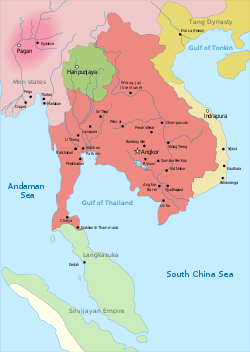
Back Khmer-ryk Afrikaans إمبراطورية الخمير Arabic ক্ষ্মেৰ সাম্ৰাজ্য Assamese Imperiu khmer AST Khmer imperiyası Azerbaijani خمر ایمپراتورلوغو AZB Кхмерская імперыя Byelorussian Кхмерска империя Bulgarian খেমার সাম্রাজ্য Bengali/Bangla Kmersko carstvo BS
Kambuja | |||||||||||||
|---|---|---|---|---|---|---|---|---|---|---|---|---|---|
| 802–1431 | |||||||||||||
 The Khmer Empire (Kambuja), c. 900 | |||||||||||||
| Capital |
| ||||||||||||
| Liturgical language | Sanskrit[a] | ||||||||||||
| Spoken language | Old Khmer | ||||||||||||
| Religion | Hinduism Buddhism | ||||||||||||
| Government | Absolute monarchy ruled by a divine king | ||||||||||||
| King | |||||||||||||
• 802–850 | Jayavarman II (first) | ||||||||||||
• 1417–1431 | Borom Reachea II (last) | ||||||||||||
| Historical era | Post-classical | ||||||||||||
| 802 | |||||||||||||
• Construction of Angkor Wat | 1113–1150 | ||||||||||||
| 1431 | |||||||||||||
| Area | |||||||||||||
| 1290[1][2] | 1,000,000 km2 (390,000 sq mi) | ||||||||||||
| |||||||||||||
| History of Cambodia |
|---|
| Early history |
| Post-Angkor Period |
| Colonial period |
| Independence and conflict |
| Peace process |
| Modern Cambodia |
| By topic |
|
|
The Khmer Empire was a Hindu-Buddhist empire in Southeast Asia, centered around hydraulic cities in what is now northern Cambodia. Known as Kambuja by its inhabitants, it grew out of the former civilisation of Chenla and lasted from 802 to 1431. Historians call this period of Cambodian history the Angkor period, after the empire's most well-known capital, Angkor. The Khmer Empire ruled or vassalised most of mainland Southeast Asia[3] and stretched as far north as southern China.[4][5] At its peak, the Empire was larger than the Byzantine Empire, which existed around the same time.[6]
The beginning of the Khmer Empire is conventionally dated to 802, when Khmer prince Jayavarman II declared himself chakravartin (lit. 'universal ruler', a title equivalent to 'emperor') in the Phnom Kulen mountains. Although the end of the Khmer Empire has traditionally been marked with the Fall of Angkor to the Siamese Ayutthaya Kingdom in 1431, the reasons for the empire's collapse are still debated amongst scholars.[7] Researchers have determined that a period of strong monsoon rains was followed by a severe drought in the region, which caused damage to the empire's hydraulic infrastructure. Variability between droughts and flooding was also a problem, which may have caused residents to migrate southward and away from the empire's major cities.[8]
The site of Angkor is perhaps the empire's most notable legacy, as it was the capital during the empire's zenith. The majestic monuments of Angkor, such as Angkor Wat and the Bayon, bear testimony to the Khmer Empire's immense power and wealth, impressive art and culture, architectural technique, aesthetic achievements, and variety of belief systems that it patronised over time. Satellite imaging has revealed that Angkor, during its peak in the 11th to the 13th centuries, was the most extensive pre-industrial urban complex in the world.[9][10] Researchers have also concluded that the Khmer Empire invented the world's first healthcare system, which included 102 hospitals.[11]
Cite error: There are <ref group=lower-alpha> tags or {{efn}} templates on this page, but the references will not show without a {{reflist|group=lower-alpha}} template or {{notelist}} template (see the help page).
- ^ Turchin, Peter; Adams, Jonathan M.; Hall, Thomas D (December 2006). "East-West Orientation of Historical Empires". Journal of World-Systems Research. 12 (2): 223. ISSN 1076-156X. Archived from the original on 20 May 2019. Retrieved 16 September 2016.
- ^ Rein Taagepera (September 1997). "Expansion and Contraction Patterns of Large Polities: Context for Russia". International Studies Quarterly. 41 (3): 493. doi:10.1111/0020-8833.00053. JSTOR 2600793. Archived from the original on 17 August 2018. Retrieved 7 September 2018.
- ^ "Khmer Empire | Infoplease". www.infoplease.com. Archived from the original on 12 October 2012. Retrieved 15 January 2023.
- ^ Reynolds, Frank. "Angkor". Encyclopædia Britannica. Encyclopædia Britannica, Inc. Archived from the original on 26 July 2019. Retrieved 17 August 2018.
- ^ Plubins, Rodrigo. "Khmer Empire". World History Encyclopedia. Archived from the original on 17 April 2021. Retrieved 17 August 2018.
- ^ "Galloway, M. (2021, May 31). How Did Hydro-Engineering Help Build The Khmer Empire? The Collector. Retrieved April 23, 2023". 31 May 2021. Archived from the original on 12 November 2021. Retrieved 12 November 2021.
- ^ "LOVGREN, S. (2017, April 4). Angkor Wat's Collapse From Climate Change Has Lessons for Today. National Geographic. Retrieved March 30, 2022". National Geographic Society. Archived from the original on 28 March 2022. Retrieved 30 March 2022.
- ^ "Prasad, J. (2020, April 14). Climate change and the collapse of Angkor Wat. The University of Sydney. Retrieved March 30, 2022". Archived from the original on 24 May 2022. Retrieved 30 March 2022.
- ^ Damian Evans; et al. (9 April 2009). "A comprehensive archaeological map of the world's largest preindustrial settlement complex at Angkor, Cambodia". Proceedings of the National Academy of Sciences. 104 (36): 14277–82. Bibcode:2007PNAS..10414277E. doi:10.1073/pnas.0702525104. PMC 1964867. PMID 17717084.
- ^ "Galloway, M. (2021, May 31). How Did Hydro-Engineering Help Build The Khmer Empire? The Collector. Retrieved November 12, 2021". 31 May 2021. Archived from the original on 12 November 2021. Retrieved 12 November 2021.
- ^ "Bunthoeurn, O. (2022, July 21). Khmer Empire had 'world's first' system for healthcare. The Phnom Penh Post. Retrieved August 9, 2022". Archived from the original on 10 August 2022. Retrieved 10 August 2022.